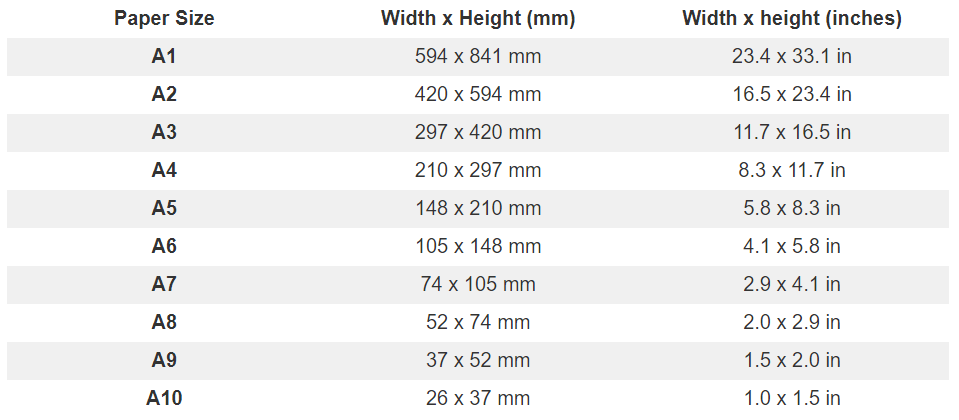Are you looking to print your photos, but you’re not sure what print size to use? Are you struggling to determine which of the standard photo print sizes is right for you?
In this article, I’m going to clear up everything related to print sizes – what they are, what’s feasible given your image dimensions, and whether you need to consider common aspect ratios when printing. I’ll close with a list of common picture sizes so that you get a sense of the options available to you.
LET’S TALK ABOUT PAPER SIZES!
A size
Most printer users are probably already aware of ‘A size’ paper. These are the most widely used, and easily distinguishable paper sizes. These paper sizes are simple to understand, as they increase and decrease in successive order, with A1 being the biggest paper size and A10 the smallest.

A4 Size
A4 paper is the most commonly used for printing and measures 210mm x 297mm. This paper comes in many different weights and with several different coatings, meaning there is an A4 paper that is suitable for any printing job. This paper size is not only suitable for everyday tasks but can usually fit special purposes too.
A3 Size
A3 paper sizes measures 297mm x 420mm, which is twice the size of A4 paper. This larger sheet allows you to print documents that need to make more of a visual impact, including large graphic pieces or high-resolution images. Large format A3 printers are extremely versatile as they have the ability to print in both A3 and A4, along with having faster print engines.
Other A sizes
Smaller A sizes such as A5 and A6 are also available, which are great paper options for printing flyers or other small media. There are also larger options like A2 and A1 which allow you to print posters and banners.
C size
C size paper is a range of paper used exclusively for envelopes. The sizes vary from C1 to C10, and mainly correspond to their similar sizes in the A range of paper, although by design they are slightly bigger. This marginal difference in size allows the similar A-size sheet to fit inside the envelope.

different types of Paper for Printing
Each type of paper has unique features that can be beneficial depending on what type of project and run you’re planning. Some of the most common paper types used in printing today are:
Inkjet Paper
While you can find inkjet paper in different variations, such as glossy or smaller sizes, the main defining feature is how the paper absorbs ink. This paper is slightly thicker than laser paper. However, the name can encompass many types of paper that work with inkjet machines. As the name implies, inkjet paper is specifically designed to work with inkjet printers to create crisp color-popping images.
Bond & Label Paper
Receipt printers, label makers, and some point-of-sale terminals use a special kind of paper known as thermal or bond rolls. This paper has a thicker, almost textile-like feel and is used for a wide range of tasks from art to business. The name thermal comes from how images are printed onto that paper in such devices as receipt printers or label makers. These printers use heat to burn the image into the paper, which cuts ink costs and prevents the smearing of images or text.
Coated vs. Uncoated
Paper often comes in either a coated sheet or an uncoated sheet option and the difference between the two is just as it sounds, in the coating. Coated paper has a coating on it so that it’s “sealed.” Uncoated paper doesn’t have a coating and in turn is porous, meaning the ink or anything printed on the sheet soaks into the sheet a bit more than in a coated version of the same sheet of paper.
Photo Paper
There are two main kinds of photo paper, glossy and matte. Glossy is the most common and likely what you will find when searching for photo paper. However, matte can be helpful in specific cases. Both types, however, are designed to print the highest quality images possible using inkjet printers. Photo paper is also thicker than laser and inkjet, making it one of the more expensive paper types available.
Specialty Paper
While many papers are sustainably sourced, some are especially environmentally friendly because of the materials used or how fast they biodegrade.
Premium Paper
Beyond standard paper stock are the premium ones that include all the top attributes of weight, coating, brightness, opacity, and material, making them good for presentations and print jobs where quality matters.
Final Word:
There are so many choices of paper or sizes of paper available that it can sometimes be difficult to know where to begin looking. This article can help clarify the possible choices so that your next printed piece can take a bow for a job well done.
